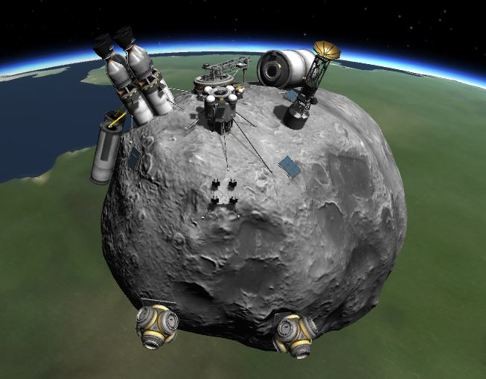Avoiding Armageddon: Nuke could turn Toutatis to space dust before asteroid potentially makes a fireball of earth, say Chinese scientists
The biggest asteroid to cross the earth’s orbit, 4179 Toutatis, poses a threat to the planet but could probably be obliterated by a nuclear warhead as it is likely just a pile of rubble glued together by microgravity, according to a new study by Chinese scientists.
The last time Toutatis - named after a Celtic god- made a “fly-by” in 2012, China sent its Chang’e 2 space probe - named after the Chinese goddess of the moon - up to get a closer look.
It got within 770 metres of the surface of the asteroid, which measures about 5 kilometres in width.
READ MORE: Reach for the stars - China wants to be first to land probe on moon’s far side
Scientists widely believe that a celestial body with a diametre one-fith this size would generate an impact that could be felt globally if it ever struck earth.
As such, even though Toutatis may seem about as threatening as a peanut rotating in space when framed against the earth’s colossal size, it could cause catastrophic damage if it were ever to touch down.
An asteroid twice its size is believed to have caused dinosaurs to become extinct 65 million years ago.
“Men are not dinosaurs. We wont accept our doomsday without a fight,” said Professor Ji Jianghui, lead scientist of the latest study.
Ji works at the Purple Mountain Observatory in Nanjing, in east China’s Jiangsu province. It operates under the auspices of the Chinese Academy of Sciences.
Various groups of scientists have long been studying the physical properties of Toutatis and other asteroids whose orbits cross those of earth to find the best way of eliminating the threat they pose.
In light of recent technological advances, various options have been proposed, such as blowing it into small and harless fragments - as in the Hollywood movie Armageddon - or changing its course with the use of rocket engines. However the best approach remains a hotly debated subject.
READ MORE: Now that’s scary: 400-metre-wide asteroid to zoom ‘close’ by Earth on Halloween
The Chinese probe’s mission in 2012 delivered crucial information about Toutatis that significantly improved the scientific community’s overall understanding of it, Ji said.
Originally designed for lunar missions, Chang’e2 took hundreds of high-definition photographs of the asteroid that provided some of the first-ever views of the celestial body.
Earlier analysis showed it to have a peanut-shaped structure, which prompted Ji and his colleagues to suspect it was composed of different segments pulled together by gravity.
Their new study, published in Scientific Reports this week, confirmed their belief that is was more than just a single lump of space rock.
Ji and collaborators from Taiwan, Macau and the United States found it had rocks scattered evenly across its surface “without local concentration around craters”.
This implies it was formed over a long time without any major disturbances, they said, as it didn’t show evidence of a history of collisions or other violent forms of impact in its creation.
“Toutatis probably has a rubble-pile structure, as most of the boulders on its surface cannot be explained by impact catering,” they wrote in the paper.
In a phone interview later with the South China Morning Post, Ji said a structure like this could prove a blessing or a curse.
“A loose structure would make it easier for us to disintegrate the asteroid using a bomb, should it head our way one day,” he said.
But such as detonation could also result in the splintering off of fragments large enough to penetrate the atmosphere, which would also do harm when they hit earth, he added.
Meanwhile, attempting to mount rocket engines on the asteroid could change its course, but the force must be precisely calculated or the manoeuver could also tear the structure apart.
Ji and his team were also the first to estimate Toutatis’ youngest possible age. Its craters are at least 16 billion years old, according to their paper.
Of course it may be much older, they conceded. The research community is still puzzled as to its true age.
Ji said his team is conducting more in-depth analysis of the images sent back by Chang’e 2 in hope of removing more of the question marks hovering over it.
This include the precise physical mechanism that led to its formation, and how such weak levels of gravity could pin it together for billions of years. Its inner structure is also something of a mystery.
While Toutatis is not expected to cross the earth’s orbit for another half-century or so, a number of smaller but potentially more asteroids keep the threat level high.
One called 101966 Bennu measures just 500m in diametre but has been rated as among the most likely to collide with the earth in the near future. One study warns this is likely to happen between 2169 and 2199.
The United States was the first country to track dangerous asteroids. Even today, it runs the world’s biggest network of observatories dedicated to that task.
Nasa plans to send a space probe to Bennu in 2016 and bring back samples that can be analysed.
Washington continues to lead the hunt for such celestial threats and China is a latecomer to the field, Ji said, adding that Chang’e 2 was unable to provide some needed data when it got up close and personal with Toutatis.
Decades after the US finished its asteroid alert system, China’s version is still under construction, but the country is catching up quickly, Ji said.
“We are busy making preparations for some very exciting missions in the future,” he said.
Although no official announcement has been made, the central government has decided to send more probes to study asteroids deemed a threat, he added.
http://www.scmp.com/tech/science-research/article/1876002/avoiding-armageddon-nuke-could-turn-toutatis-space-dust




No comments :
Post a Comment